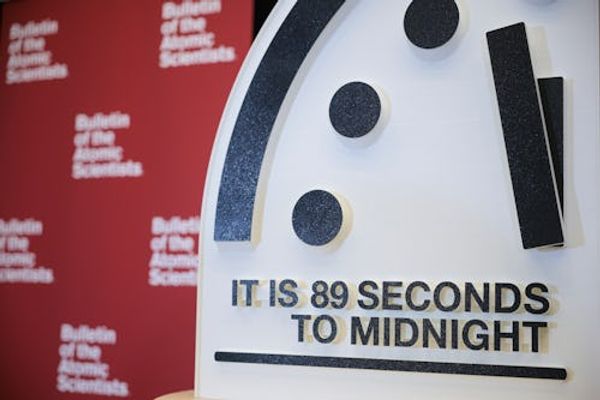The world is closer than ever before to total apocalypse, the scientists behind the Doomsday Clock have warned.
The Bulletin of the Atomic Scientists – the group that sets the time of the clock, which is intended to show the chance of annihilation from a range of threats – said that it was moving the clock forwards once more.
The clock now stands at 89 seconds. For the last two years, it has been at 90 seconds – itself already closer than ever before.
The Doomsday Clock was begun in 1947, as a metaphor for the danger that the world was facing. Then, it was primarily intended as a way of expressing the possible dangers from nuclear warfare, though it has taken in other threats such as artificial intelligence and climate change since then.
Until the last decade, the closest the world had been to midnight came shortly after the clock’s founding, in the 1950s, when the clock reached two minutes to midnight. In 2018, amid increasing global tensions, scientists moved it back to two minutes to midnight, and it has been creeping closer in the time since.
For almost all of its history, the clock has moved in 60-second increments. In 2017 it was moved to two-and-a-half minutes to midnight, and then in 2020 it was moved to 100 seconds. This is the first time the clock has been moved by a second.
“The factors shaping this year’s decision – nuclear risk, climate change, the potential misuse of advances in biological science and a variety of other emerging technologies such as artificial intelligence – were not new in 2024. But we have seen insufficient progress in addressing the key challenges, and in many cases this is leading to increasingly negative and worrisome effects,” said Daniel Holz, chair of the Bulletin’s science and security board.
“Setting the Doomsday Clock at 89 seconds to midnight is a warning to all world leaders,” Professor Holz added.
Russia’s 2022 invasion of Ukraine launched Europe’s bloodiest conflict since the Second World War.
“The war in Ukraine continues to loom as a large source of nuclear risk. That conflict could escalate to include nuclear weapons at any moment due to a rash decision or through accident and miscalculation,” Prof Holz said.
In November, Russian president Vladimir Putin lowered the threshold for a nuclear strike in response to a broader range of conventional attacks, a move the Kremlin described as a signal to the West amid a war in which Ukraine has received arms supplied by the United States and its allies. Russia’s updated doctrine set a framework for the conditions under which Putin could order a strike from the world’s biggest nuclear arsenal.
Russia said in October that it would not discuss signing a new treaty with the United States to replace the New Strategic Arms Reduction Treaty – an agreement that limits each side’s strategic nuclear weapons, which expires in 2026 – because Moscow believes it needs to be broadened to cover other countries.
“Russian aggression in Ukraine, including repeated use of nuclear threats since the war began, has been disturbing. In addition, Russia’s recent backtracking from important arms control treaties is an alarming sign of increasing nuclear risk,” said Prof Holz.
The Middle East has been another source of instability, with the Israel-Gaza war and broader regional hostilities involving countries including Iran. Nuclear-armed China has stepped up military pressure near Taiwan, sending warships and planes into the waters and air space around the island, which Beijing views as its own territory. Nuclear-armed North Korea has continued its tests of various ballistic missiles.
“We are watching closely and hope that the ceasefire in Gaza will hold. Tensions in the Middle East including with Iran are still dangerously unstable,” Prof Holz said. “There are other potential hot spots around the world, including Taiwan and North Korea. Any of these could turn into a conflagration involving nuclear powers, with unpredictable and potentially devastating outcomes.”
Artificial intelligence made rapid gains in capability and popularity in 2024, prompting increasing concern among some experts about its military applications and its risks to global security. Governments have addressed the matter in fits and starts. In the United States, for instance, Joe Biden signed an executive order in October that was intended to reduce the risks that artificial intelligence poses to national security, the economy, and public health or safety. His successor, Donald Trump, last week revoked it.
“Advances in AI are beginning to show up on the battlefield in tentative but worrisome ways, and of particular concern is the future possibility of AI applications to nuclear weapons. In addition, AI is increasingly disrupting the world’s information ecosystem. AI-fuelled disinformation and misinformation will only add to this dysfunction,” Prof Holz said.
Last year was the hottest in recorded history, according to scientists at the UN World Meteorological Organisation. The last 10 years were the 10 hottest on record, it said.
“While there has been impressive growth in wind and solar energy, the world is still falling short of what is necessary to prevent the worse aspects of climate change,” said Prof Holz.
Additional reporting by agencies










